i hate offering scholarships to fullbacks
Fuller
Question: Did you notice any appreciable difference in the Spring Game between the Borges offense and Nussmeier's? What are hoping to see by fall, and do you think they appeared to be heading in that direction?
Ace: Well...

I might not be very useful in this roundtable.
--------------------------
Brian: Well... it wasn't much different in person.
And the stuff they did show was the usual vanilla business that is designed to be as basic as possible, so I'm not sure there's a whole lot to glean. It looked a lot more compact than last year's offense, sure. All spring games look compact as the bells and whistles are stowed away for use on a two-point conversion in the bowl game after you're down one billion points.
Michigan did seem to have a dedication to the inside zone with a side of power, and the linemen seemed more focused on making sure the defensive tackle was good and beat up before trying to get to the second level. That led to a lot of runs that made it to the line of scrimmage (hooray!) and didn't get much further. And that's fine. You don't dig out of a hole as big as the one Michigan's in quickly. Michigan looks like it's going to be mostly an IZ team that mixes in power to keep opponents honest, and as long as they look like that through the nonconference season and don't start flipping people about all willy-nilly, that is the first step towards competence.
So that's what I think we'll see: a boring-ass offense that tries to keep errors to a minimum and punts a lot. People will complain about its predictability and simplicity and they'll be right. Michigan doesn't have much choice, unfortunately.
--------------------------
Seth: It's impossible to compare Borges's Michigan offense to anything, because Michigan's offense wasn't anything under Borges for more than a few games. The three things I was looking for were 1) personnel, 2) a concept, and 3) how well those things could complement each other.
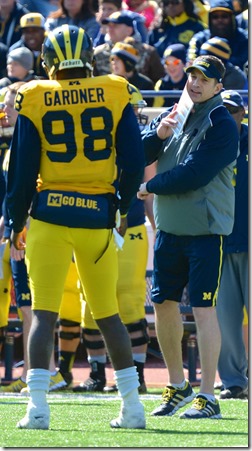 |
| If you flup this up, Doug, so help me Bo… |
Personnel was heavy, which was discouraging. For one Michigan has little in the way of tight ends. I didn't see anything from A.J. Williams, who was behind Heitzman, or Khalid Hill, who was behind Houma, and that was discouraging for hope of TE production before Butt's back. Houma is a fullback who lined up at the U only to motion back to fullback.
The operating theory on the OC hire was that Nussmeier at Bama was forced to use heavier formations than he wanted, however that compromise came down to 65% of snaps with three or more receivers:
| Team | Big | 2 WR | 3 WR | 4 WR |
|---|---|---|---|---|
| Bama (Sugar Bowl) | 3% | 31% | 58% | 7% |
| Michigan 2013 | 8% | 54% | 29% | 9% |
| Mich 2011-'12 | 7% | 41% | 43% | 9% |
| Mich 2008-'10 | 1% | 7% | 76% | 15% |
Eyeballing it, the spring game was closer to Michigan in 2013. If there was a difference it was more Ace as opposed to I-form, but that's less relevant because those second TEs were usually Houma and Kerridge, i.e. the fullbacks. There's a fear shared by every Michigan fan with a functional nervous system that the run-and-shoot-yourself-in-the-face offense under Borges was, despite protestations to the contrary, a mandate from the top. If Nussmeier compromises for Hoke more than he would for Saban, well, that would be insane. If that was all just a bunch of spring practice hooey, well, why are they spending spring practice on hooey when every countable hour is precious?
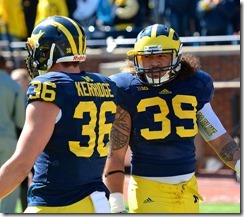 |
| Great scott Doc, this is too heavy. [Fuller] |
On the upside, there was a concept. The running was mostly zone, with some power mixed in only because you need to pull somebody to sell play-action. The passing game was a slight departure from Borges, who used a lot of 5-step patterns last year. These were 7-step patterns with an outlet, matching what we saw from Nussmeier at Alabama. The difference here can be overstated; Borges used lots of longer routes with Denard but went to the quicker stuff in 2013 because he couldn't get protection to last longer than that.
How do I feel about that? Well it fits the receivers' abilities. There's no Gallon to turn every 7-yard cushion into an easy 5 yards, but there's Canteen and the Funchise and lots of leapy things who can reel in a desperation heave. I have serious doubts the offensive line can hold up that long, but that's why there's an outlet. On the play I drew up it was Funchess running what appeared to be an option route; with Alabama it was usually an RB.
Zone is good. It's what Funk knows, it's easier to teach to young linemen, and we've already established his charges' total inability to pull correctly. My guess is the tight ends are in there because the OTs need help, though any time you have Heitzman/Williams/Houma in there instead of Chesson that's a talent downgrade.
I think the great hope for an offense that can finish in the top half of the conference is Gardner. I think Nussmeier is building an offense that is simple for everybody but him.
Fuller didn't get a shot of Dileo that he put on Flickr, but he got this 6-yard catch by Butt on 2nd and 5, when Dileo was busy running off two defenders.
The primary complaint with Michigan's offense, rightly, has been with the blocking dudes' problems with blocking dudes. While gathering data on personnel changes throughout the Northwestern game I got an opportunity to look hard enough to have an idea where the UFR will lay blame for 9 points in regulation. Preview: Bosch didn't have a good game. However the freshman guards are a problem solved mostly by experience, i.e. we can't fix it this year.
But if Michigan is looking for an offensive boost it might find one by improving which parts they deploy among the five eligible receiver positions. Which personnel and how they're aligned come with various strengths. Generally the smaller and more spread out, the better to make space for you to operate; conversely the larger and tighter the better to block dudes. I put forth that our blocking dudes are currently pretty bad at blocking dudes, thus it's worth moving some of their snaps to 3rd and 4th receivers.
MANBALL isn't Borgesian
Here's Borges's offense being run at UCLA in 1998, a time when the spread offense was something that won games at Tulane:
Note the 3WR sets pop up plenty. I believe the goal here is to be multifarious, not just very large and good at something. He wants to be impossible to prepare for because at any moment you might put in your 4-4 personnel when you see him trotting out 3 tight ends, and then he'll spread them out and put a 6'6 monster on your tiniest cornerback. This is why they're recruiting Fifty Shades of Shea.
But That's a Long Way Away
Today, they have precious few developed parts to play these "skill" positions. The running backs can't block, either because they're really spread nutrinos (Toussaint, Hayes, Norfleet) or true freshmen (Green, Smith) who didn't need blocking lessons to run over high school fools. The fullbacks are a walk-on they've been developing for awhile but who still misses 1 in 5 blocking assignments, and a RS freshman they recruited out of Utah who needs work.
| Off. Performance vs. NW'ern When Player is On Field (Only normal downs counted) | ||||
|---|---|---|---|---|
| Player | Pos | Snaps | YPA | Run% |
| Gallon | WR | 60 | 5.45 | 48% |
| Funchess | WR | 54 | 5.74 | 46% |
| Williams | Y | 41 | 5.46 | 54% |
| Green | RB | 40 | 5.45 | 53% |
| Butt | TE/WR | 39 | 4.69 | 49% |
| Kerridge | FB/RB | 23 | 4.52 | 43% |
| Dileo | WR | 10 | 9.00 | 20% |
| Smith | RB | 9 | 5.22 | 78% |
| Hayes | RB | 8 | 5.63 | 13% |
| Chesson | WR | 7 | 5.00 | 29% |
| Paskorz | TE | 6 | 5.33 | 67% |
| Houma | FB/TE | 4 | 4.50 | 100% |
| (Total) | n/a | 60 | 5.43 | 48% |
From a Borgesian perspective, the tight ends are in even worse shape. Funchess became a receiver because despite all that size he's not much of a blocker. That leaves his classmate A.J. Williams at the top of the depth chart despite the fact that he's not been a very good blocker, and his threat as a passing target fizzles out about three yards downfield. They've got Jake Butt, who like Funchess is more of a receiver at this stage in his career. And just so they have another body there, positional vagaband Jordan Paskorz has been getting a few drives here and there; after him it's burning a redshirt and air.
It would make sense, then, for the receivers to pick up the slack. If you can't block a guy with Williams, you can get that same block by putting a receiver far away from the play, so long as you threaten to go out there if a defender doesn't follow. But there's another problem with the receivers: Gallon is great but tiny, Funchess is great but still raw. Chesson is coming along. Dileo is himself.
And…? The coaches seem to have put every other receiver on the shelf: they've played Jeremy Jackson a lot and gotten little returns. Joe Reynolds seems to be not an option. So every time they go 4-wide, effectively the whole depth chart is out there. Exhaust those guys and the passing game goes away. Or at least this is the best reason I can imagine.
I'm not sure it's a good reason. It seems to me that they're pretty effective the more they spread 'em out, because you're essentially replacing a mediocre-to-bad FB or TE with a slot receiver who is pretty good at that job.
Did You See Dileo's Number in that Chart?
I spent much of yesterday and all night last night charting the personnel moves during last Saturday's game to be able to pull those numbers. The whole thing is here:
There's no way I can go back and do the whole season, unless Brian has a secret code hidden in the UFRs or something. Anyway: 9 YPA when Dileo is out there, and 4.5 to 5.5 when he's not. Here's some other things I found in there.
[After the Jump: What We've Learned]
I'm trying out a new feature of mouse-over tags so readers who don't get some of our references can get caught up. Underlined text has a tag. If the tag is a link then you've found a link. I appreciate any feedback on its deployment.
Left: Young Wolverines some of whom were recruited for power (Upchurch). Right: Power.
Chris Brown's recent article on Smart Football included a link to a 1997-vintage article by Bill Walsh (YTBW). Chris included it as a way of crediting Walsh for correctly predicting Tony Gonzalez would become a great NFL tight end. With Michigan transitioning further toward a Walsh-ian offense, I thought I'd appropriate the whole article to see how well Michigan's 2013 offensive roster matches Walsh-ian archetypes.
Before we jump in, you'll recognize a lot of what's said here from like every NFL draft report ever. Walsh's coaching tree perforated the league for years, and that meant the things he tended to look for in players became what most of the people making draft decisions were looking for. They've been repeated so often as to become memes, however I still think going back to the source can provide some insight into how Michigan's players and recruits are being evaluated.
This is all intended to help you do your own scouting when we publish things like Hello posts (lots of those coming up) and positional previews.
Quarterback
Tom Brady prototype, Tom Brady, Tom Brady with legs? --Bryan Fuller
Walsh Says: 6'3, 210. Having a strong arm isn't as important as an "inventory" of passes, although decent arm strength is a necessity:
"Arm strength is somewhat misleading. Some players can throw 80 yards, but they aren't good passers. Good passing has to do with accuracy, timing, and throwing a ball with touch so it is catchable…
"Remember, the goal of passing a ball is to make sure it is caught ... by your intended receiver."
The most important characteristic for a quarterback is intuition/instincts. He has to be able to sense the rush, make the right decision quickly and get the ball "up and gone," and handle progressions and broken plays with grace as opposed to a sense of urgency.
"The single trait that separates great quarterbacks from good quarterbacks is the ability to make the great, spontaneous decision, especially at a crucial time."
Walsh wants his quarterback to be "courageous and intensely competitive." He also wants them mobile and defines it thus:
Mobility and an ability to avoid a pass rush are crucial. Some quarterbacks use this mobility within the pocket just enough so they are able to move and pass when they "feel" a rush. But overall quickness and agility can make a remarkable difference. As an example, there were some very quick boxers in Sugar Ray Leonard's era, but he was quicker than they were and because of that he became a great champ.
Walsh's Favorite Wolverine: Tom Brady, obviously. Tate Forcier.
What to look for in a Scouting Report: High accuracy plus high YPA. "Makes things happen."
What you can learn on film: Doesn't make you nervous. Escapes from pressure then seems calm, not rushed. Sees something and reacts quickly. Receivers aren't making tough catches or breaking stride.
What could signal bust potential: First a warning on this part not to take it as "anyone who exhibits this trait will bust." What I'm saying is beware a guy ranked highly because this feature he possesses, which is a good thing to possess, may be overrated. Here it's arm strength—more an NFL problem than college since college QBs can learn systems and Navarre their way to great college careers with only one type of pass. Arm strength with no accuracy and a terrible delivery can turn into a great player if he's got an innate sense (think Stafford), but more often a coach will try to fix it and end up with a Dontrelle Willis.
How our guys compare: So far only Devin Gardner has seen substantial play against college defenses but we've gotten about a game's worth of Russell Bellomy too. Gardner's inventory has passes for finding Gallon 40 yards downfield, zips that only Dileo can get to, and even that Stafford-y thing he flipped to Dileo in the Outback Bowl. He has ideal size, and wins the mobility category over everybody not named Denard Robinson. If you give him a lane to pick up yards with his legs he will take it. And he MAKES PLAYS, those coming first to mind being where he runs around in the backfield defying sack attempts until something worthy of forward progress appears.
His weakness so far has been in that crucial "up and gone" aspect. His delivery has a long wind-up and that exacerbates a medium-to-mediocre diagnosis-reaction speed. Previous spring games when Devin looked really bad at this suggest it wasn't a few months as a receiver to blame, although that obviously didn't help. Gardner will live and die by his scrambling and ability to make linebackers freeze in coverage when he takes a step forward. He's not Tom Brady, but Gardner's package can equal a helluvah good college QB. An offseason as quarterback in a system designed to his strengths puts the ceiling high for 2013, and off the charts if there ends up being a 2014.
Russell Bellomy (right-Upchurch) in his few appearances last year—mostly the 2nd half 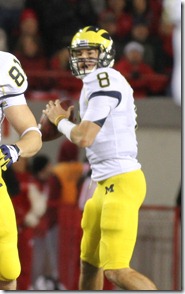 against Nebraska—gave us a fairly strong indication of his abilities. He wins Walsh points by having a catchable ball, but there it ends. His apparent lack of arm strength severely limits the inventory, his agility isn't anything special vs. Big Ten defenders, and while you can forgive a freshman thrust into starting for this, he showed a lot of panic. I am skeptical that he can contribute on this level unless his arm strength improves as much as I expect his comfort will.
against Nebraska—gave us a fairly strong indication of his abilities. He wins Walsh points by having a catchable ball, but there it ends. His apparent lack of arm strength severely limits the inventory, his agility isn't anything special vs. Big Ten defenders, and while you can forgive a freshman thrust into starting for this, he showed a lot of panic. I am skeptical that he can contribute on this level unless his arm strength improves as much as I expect his comfort will.
Shane Morris, now. Other than every scouting thing they can do with high schoolers, it's hard to say what he will turn out to be. The senior year performance and the thing that guy said in the Elite 11 about his primary read being taken away are marks against the Walsh archetype, but the size and arm and full inventory are there. He's too young to know if he will develop the rest.
Running Back
Terrance Flagler, A-Train, Toussaint –Upchurch
Walsh Says: Needs to be big enough to take punishment and always fall forward, but "some smaller runners play big." He uses James Brooks but of course we've got our own exempli gratia. The 1B for backs is again, instincts, though he emphasizes getting "the first four yards within the scheme and then rely on instincts to take it beyond that."
Walsh puts a high value on durability, which maybe isn't as important in college where the hits are lighter and the roster is deeper. The other thing he harps on is instinct, mentioning he got burned on this with Terrance Flagler. This is the difference between Michael Shaw and Mike Hart.
After that he goes into bonus features. If he can block he doesn't have to come off the field in passing situations. He has to be able to catch a screen and the further down the field he can threaten as a receiver the more "dimensional" the offense becomes.
Walsh's Favorite Wolverine: Anthony Thomas. Always falling forward, instinctual enough to be a kick returner before becoming the feature back.
What to look for in a Scouting Report: At least 185 lbs., thick and squat. Numbers don't tank against high-level competition.
What you can learn on film: Defenders look like bad tacklers (subtle movements by the RB make him tough to set up on). Falling forward, durability, operating in small spaces. Lots of D-I ticketed RBs will run sweeps all the time because their speed is just unfair against high school DEs. Watch the inside and zone running.
What could signal bust potential: Beware the big backs who wrack up huge high school yardage by running through terrible tacklers. It's hard to tell the guys who can subtly shift their bodies to make themselves difficult to bring down from the ones who just truck over a division full of future doctors and lawyers. One strong attribute can sometimes dominate a bad high school league, but D-I football requires several working together.
How our guys compare: Toussaint has shown the instincts and "plays big" at near the extreme for smallness. He looked on his way toward being a zone-style feature complement until having the unluckiest year in recent Michigan RB history. Justice Hayes is like Toussaint except he's yet to show those instincts. Dennis Norfleet has the playmaker thing down but there's a major difference in size between him and the other guys. Norfleet was listed at 5'7/161 last year, and Vincent Smith was put at 5'6/175. Hayes was 5'10/183 and Toussaint 5'10/202. Norfleet/Smith and Toussaint/Hayes are different tiers.
Among the plowshares, thick-trunked Thomas Rawls saw extensive action last year. The difference between him and Mark Ingram is Rawls seems to miss his hole a lot—that "first four yards" thing is a problem. I haven't seen enough of Drake Johnson yet to know if he brings anything different. None of the above (who are still on the roster) have yet to demonstrate they're any better than mediocre blockers.
Two incoming running backs come with the Walsh stamp of approval. Green is already 220 lbs. and his senior highlight reel shows him doing a lot of inside power running and finding his extra yards. Deveon Smith is already Toussaint-sized and seems to have that micro-instinctual quality that Hart had. No idea if either of these guys can block.
[The rest of the offense after you JUMP]

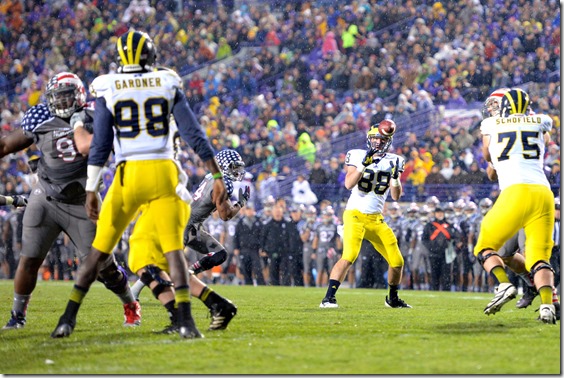


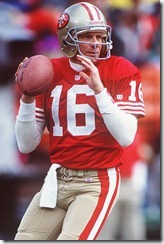

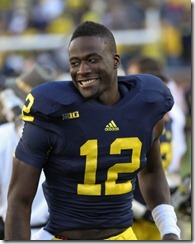
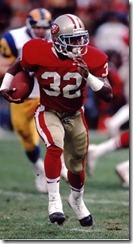
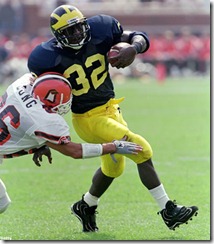
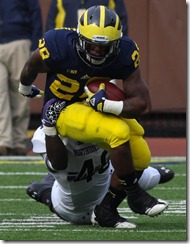
71